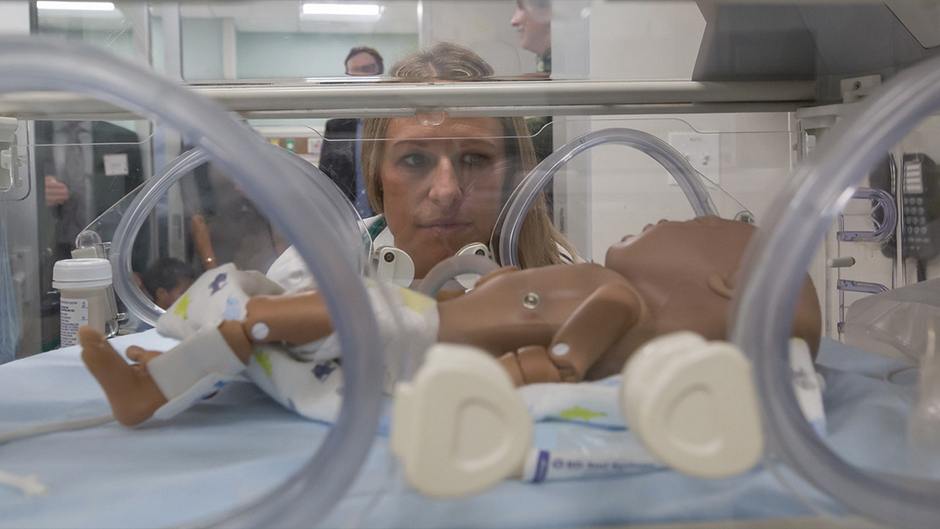The Simulation Hospital dedication ceremony on September 28 provided guests with an unforgettable afternoon: Scores of “shooting victims” resuscitated; multiple intubations, injections and intravenous medications administered; families instructed on caring for infirm loved ones; first-time “mothers” counseled on their infant’s care—even a few natural “births.”
Wine and canapes and key-lime tarts helped ease the “tension.”
“Today is a monumental day in the history of the School of School of Nursing and Health Studies and the University,” said Cindy Munro, dean of the school, in welcoming more than 280 guests in the new hospital’s filled-to-capacity auditorium. Munro thanked the many whose support and leadership transformed the idea for the hospital into a peerless five-story, 41,000-square-foot, state-of-the-art facility.
“The Simulation Hospital offers us the opportunity to have a global impact. Yesterday’s simulation practice compares to this like a slide rule compares to a super computer,” Munro said.
UM President Julio Frenk told the audience that the facility launches a new vision for health care education in our community and beyond while promoting one of the “noblest professions”—nursing. “The Simulation Hospital allows us to be better positioned to raise the level of care in the many moments of crisis that we all experience.”
The president stressed the importance of “practice, practice, practice” to master any profession or area of life that the new facility affords students.
“The new hospital exploits that powerful source of learning where you do that without causing any harm to anyone,” he said.
“Incredible, truly amazing, all the things that you’re able to do with simulation for students here,” said Linda Comer, dean of the School of Nursing and Health Studies at Florida Southern College in Central Florida. Comer and her husband traveled to Miami to attend the ceremony and the symposium that took place September 29. She was looking for ideas that might be replicated at her college.
“It’s not the mannequins—it’s how you use them,” said Comer.
Guests at the dedication followed self-guided tours to eight simulation rooms, featuring ambulatory care, an emergency department, a neo-natal intensive care unit, a birthing suite, operating room, intensive care unit and home-health transitional care apartment. At each unit, health care professionals demonstrated “real” medical crisis scenarios.
The traditional ribbon-cutting ceremony took place in the Pamela Garrison Atrium, under the specially designed mural (as yet unnamed) by artist and University design architect strategist Lily Castaner and University architect Juan Rodriguez-Vela that reflects how water and nursing share the same roots of compassion and healing.
SONHS graduate Catherine Nadeau, now a lecturer at the school pursuing her D.N.P., was excited about the enhanced educational opportunities the hospital will bring.
“This is remarkable,” Nadeau said. “We lived through the construction phrase and now to see this—amazing.”
“For students, so many of the skills can be so mystifying until you get there, into a real situation. To be able to show the students actually how it should happen and how you do the procedures—like where exactly to place the stethoscope to listen to the gallop of the heartbeat—is fabulous,” Nadeau said.
Kacie Robinson and Cassie Young are both students in the SONHS nurse practitioner program. They’ve already had a few of their classes in the new facility, but haven’t yet had the chance to use the simulation mannequins.
“The hospital is more realistic—a lot closer to what we will experience in a clinical setting,” Robinson said.
The welcome presentation in the auditorium concluded with Miami-Dade Chief Fire Officer Edward Erickson, M.S.N. ’16, highlighting the role of the new hospital as a training facility for the community.
While at the podium, Erickson received an “emergency call,” then the big screen beside him went live with a health care crisis team rushing a gurney—their “patient” clinging to life—to the emergency room where the practiced team managed to revive “him.”
Florida Southern Dean Comer was very impressed with the cutting-edge video.
“For lots of people who have never seen how remarkable simulation can be, that was truly a dramatic example of the benefits and how immersive the learning can be for students,” she said.

